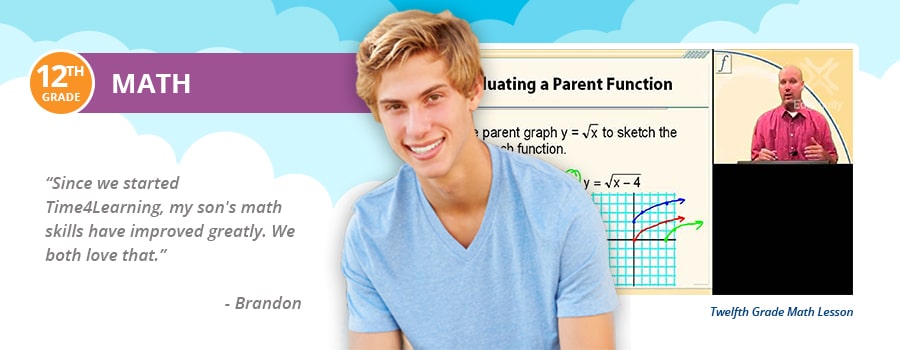12th Grade Math Curriculum
We at Time4Learning view ourselves as partners with parents in ensuring that students finish high school with the skills they need to be successful in college level courses. For mathematics, in particular, that means providing a standards-based, college-prep program that is focused on the major math concepts while using many different types of multimedia tools to engage students and inspire a greater interest in mathematics.
On this page you will discover what 12th graders should know in math, learn more about the general 12th grade math objectives, and find out how Time4Learning’s grade 12 math curriculum helps homeschool families achieve their goals for this important year of education.
Which Math Courses Should a 12th Grader Take?
For students aiming for college, 3-4 years of mathematics are recommended during high school. By 12th grade, most students will have completed Algebra I, Algebra II, and Geometry, so high school seniors may want to focus on a higher level mathematics course such as Precalculus or Trigonometry.
Students taking an advanced mathematics course will learn concepts like:
- Graphing exponential and logarithmic functions
- Probability distributions
- Sequences, series, and proofs by induction
- Trigonometric functions, transformations, and reciprocal functions
- Solving trigonometric equations
- Vectors and vector operations
Learn more about Time4Learning’s twelfth grade math curriculum below.
Objectives for High School 12th Grade Math
With STEM (Science, Technology, Engineering, and Math) careers at an all time high, it is more important than ever that high school students enter college with a strong foundation in mathematics. 12th graders who take an advanced math course during their senior year give themselves a leg up in the college admissions process–particularly if they will be majoring in a math or science-related field.
To be college-ready, grade 12 math practice should focus on building skills such as:
- Reasoning abstractly and quantitatively
- Statistical modeling
- Using appropriate tools strategically
- Modeling with probability
- Visualizing graphs of functions
- Solving systems of equations
Time4Learning 12th Grade Math Scope & Sequence
- Graphing Linear Equations
- Writing Linear Equations
- Writing Equations of Parallel and Perpendicular Lines
- Solving Equations Graphically
- Solving Quadratic Equations Algebraically
- Applications of Equations
- Inequalities
- Graphing Linear Inequalities
- Solving Systems of Equations in Two Variables
- Solving Systems of Equations in Three Variables
- Matrices
- Matrix Operations
- Modeling Motion with Matrices
- Determinants and Multiplicative Inverses of Matrices
- Solving Systems of Linear Inequalities
- Linear Programming
- Functions and Their Properties
- Operations with Functions
- Twelve Basic Functions
- Piecewise Functions
- Graphs and Transformations
- Symmetry and Coordinate Graphs
- Families of Graphs
- Graphs of Nonlinear Inequalities
- Inverse Functions and Relations
- Graphs of Rational Functions
- Direct, Inverse, and Joint Variation
- Polynomial Division
- The Remainder and Factor Theorems
- Fundamental Polynomial Connections
- The Rational Root Theorem
- Locating Zeros of Polynomial Function
- Complex Numbers
- Rational Equations and Partial Fractions
- Radical Equations and Inequalities
- Properties of Exponents
- Radicals and Rational Exponents
- Exponential and Logistic Functions
- The Number e
- Logarithmic Functions and Their Graphs
- Properties and Laws of Logarithms
- Solving Exponential and Logarithmic Equations
- Angles and Degree Measure
- Trigonometric Ratios in Right Triangles
- Angles and Radian Measure
- Trigonometric Functions on the Unit Circle
- Applying Trigonometric Functions
- Solving Right Triangles
- Cumulative Exam
- Graphs of Sine and Cosine: Sinusoids
- Graphs of Tangent, Cotangent, Secant, and Cosecant
- Graphs of Composite Trigonometric Functions
- Periodic Graphs and Amplitude
- Periodic Graphs and Phase Shifts
- Trigonometric Inverses and Their Graphs
- The Law of Sines
- The Ambiguous Case for the Law of Sines
- The Law of Cosines
- Basic Trigonometric Identities
- Verifying Trigonometric Identities
- Sum and Difference Identities
- Double-Angle and Half-Angle Identities
- Solving Trigonometric Equations
- Normal Form of a Linear Equation
- Distance from a Point to a Line
- Geometric Vectors
- Algebraic Vectors
- Dot Products of Vectors
- Vectors in Three-Dimensional Space
- Perpendicular Vectors
- Vectors and Parametric Equations
- Polar Coordinates
- Graphs of Polar Equations
- De Moivre’s Theorem and nth Roots
- Circles and Parabolas
- Ellipses
- Hyperbolas
- Classifications and Rotations of Conics
- Polar Equations of Conics
- Three-Dimensional Cartesian Coordinate System
- Basic Statistics
- Measures of Center and Spread
- Basic Probability
- Determining Probabilities
- Normal Distributions
- Arithmetic Sequences and Series
- Geometric Sequences and Series
- Infinite Sequences and Series
- Convergent and Divergent Series
- Sigma Notation and the nth Term
- The Binomial Theorem
- Special Sequences and Series
- Sequences and Iteration
- Mathematical Induction
- Limits of Functions
- Properties of Limits
- Continuity
- Limits Involving Infinity
- Derivatives and Antiderivatives
- Area Under a Curve
- The Fundamental Theorem of Calculus
- Cumulative Exam
Why Choose Time4Learning 12th Grade Math Homeschool Curriculum?
Time4Learning’s standards-based curriculum covers all of the 12th grade math learning targets listed above, plus many, many more. The advanced math courses included in our curriculum boost the critical thinking and analytical skills students will need in post-secondary education.






